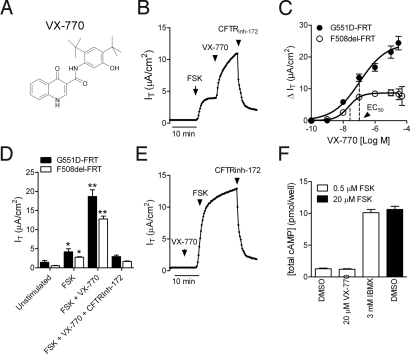Fig. 1.
VX-770 acted as a potentiator, not an activator, of G551D- and F508del CFTR in recombinant cells. (A) Structure of VX-770 (N-(2,4-di-tert-butyl-5-hydroxyphenyl)-4-oxo-1,4-dihydroquinoline-3-carboxamide)). (B) Representative IT recording from G551D-FRT showing the response to the sequential application of 10 μM forskolin (FSK), 10 μM VX-770, and 20 μM CFTRinh-172. (C) Concentration–response curve of the net increase in forskolin-stimulated IT after sequential application of VX-770 at the concentrations indicated in G551D-FRT (filled circles; n = 12) and temperature-corrected F508del-FRT (open circles; n = 5). (D) Mean (± SEM) of the IT response in G551D- (filled bars; n = 6) and F508del- (open bars; n = 5) FRT under the conditions indicated in B. Single asterisk indicates significant difference relative to unstimulated; double asterisk indicates significant difference relative to forskolin and unstimulated (P < 0.05; one-way ANOVA followed by Tukey's multiple comparison test). (E) Representative IT recording from G551D-FRT showing the response to the sequential application of 10 μM VX-770, 10 μM FSK, and 20 μM CFTRinh-172. (F) Total cAMP (cellular and secreted) was measured after 30 min incubation of FRT cells with 0.5 μM FSK plus DMSO, VX-770, and the nonspecific PDE inhibitor, IBMX (open bars) or with 20 μM FSK alone (filled bar).

